If you’ve ever heard of a hot spring, you’ve probably heard the term “onsen” thrown around, too. But what is an onsen, and is it any sort of different from a hot spring? If it is different, what makes it so dissimilar?
Keep reading to find out what an onsen is and how it’s different from a standard hot spring.
What Is an Onsen?

Japanese onsens can be indoor or outdoor.
©NattaneeP/iStock via Getty Images
While many believe “onsen” is just the Japanese word for a “hot spring,” that’s not accurate. Hot springs have many meanings throughout the world, resulting in a muddied understanding of what counts as a hot spring.
The word “onsen” can describe one of three things:
- The onsen water.
- The bath.
- The area of the onsen.
In Japan, onsens are only those public and private baths that either have heated water above 77 degrees Fahrenheit or water with a specified amount of minerals in it. These requirements, put out by the Japanese government, must be fulfilled to qualify as an onsen under onsen law.
So, onsens don’t necessarily need to be boiling. As long as they have the right amount of minerals in them, they qualify under the law as an onsen.
Japan is the only country to use the term onsen colloquially. Other countries have similar hot or warm springs but do not call them onsens.
What Is a Hot Spring?
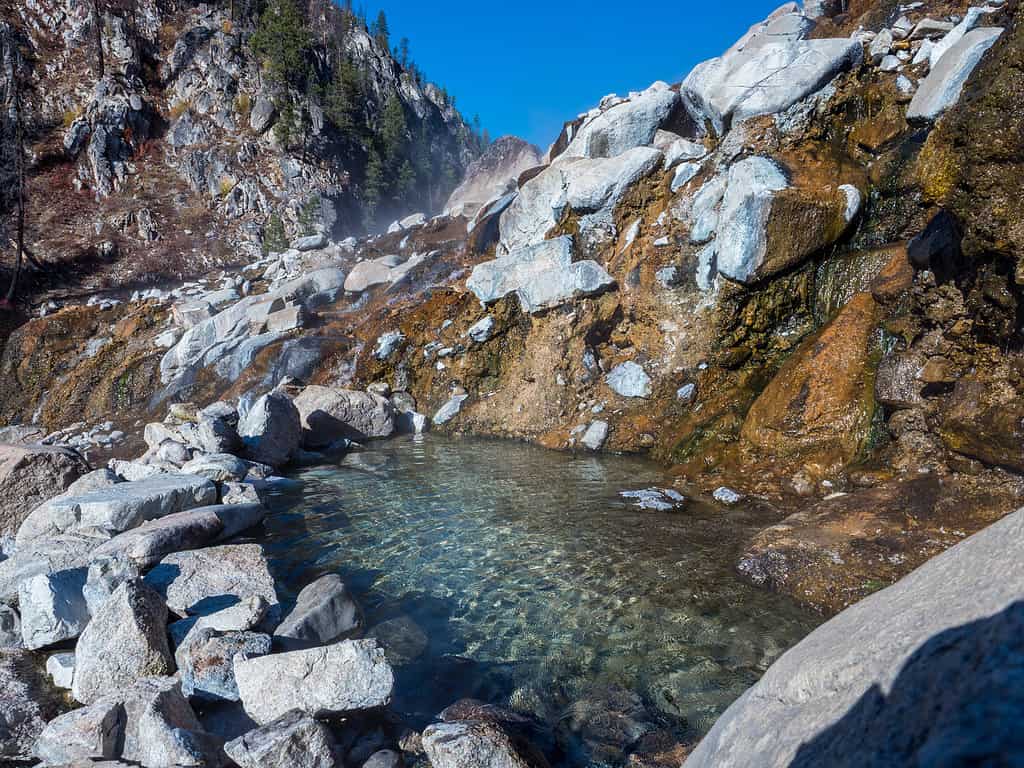
Hot springs must be a certain hot temperature.
©Kyle Little/iStock via Getty Images
Broadly, the term “hot spring” refers to a pool of water geothermically heated water. Hot springs are usually naturally occurring springs of groundwater with some sort of heated element — like hot rocks under the crust or shallow bodies of magma — that send heated water to the top of the spring.
Not all hot springs are safe for humans; in fact, dozens of ill-informed tourists have caused serious injury or death to themselves through “hot potting,” or the act of soaking in a hot spring.
Furthermore, hot springs must reach a certain temperature to be considered “hot” and not simply a warm spring.
How Do Onsens and Hot Springs Differ?
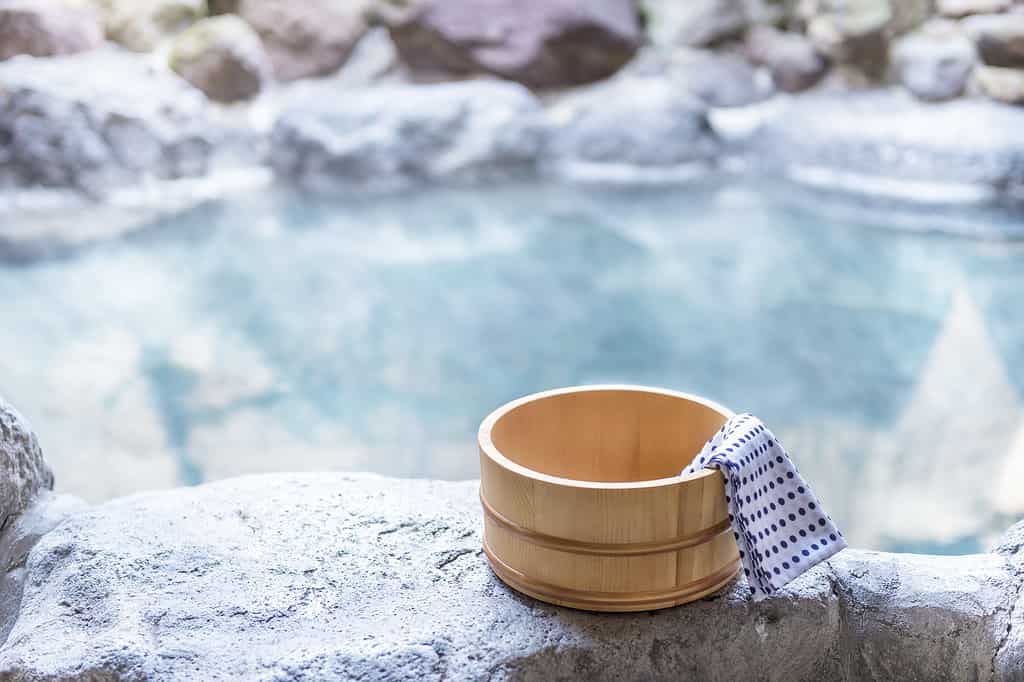
Onsens vs. hot springs: the differences come down to temperature, minerals, and accessibility.
©kuppa_rock/iStock via Getty Images
Onsens and hot springs differ in several ways: temperature, mineral content, safety, and accessibility.
As mentioned above, onsens simply need to be heated to 77 degrees Fahrenheit, or 25 degrees Celsius, as outlined by Japanese law. Hot springs, on the other hand, need to reach temperatures of well over 100 degrees Fahrenheit. Many don’t consider a hot spring “hot” until it’s reached about 120 degrees Fahrenheit or 50 degrees Celsius.
Onsens must have a specific mineral content. By law, it must contain at least one of the 19 outlined chemical elements (which include minerals like iron, sulfur, and metabolic acid). Conversely, hot springs don’t have to contain anything. Because they’re not federally regulated as a certain type of soaking bath — especially the natural ones — their mineral content doesn’t matter. Naturally, the more mineral-rich hot springs rise in popularity.
Onsen and hot spring safety vary widely from each other. Despite Japan’s small size, it features almost 30,000 unique onsens. This number includes both public bath places and the inns or resorts around the onsen. As such, the vast majority of onsens have a looked-after space around them, including lockers, changing rooms, and attached inns or spas. The lack of regulation of hot springs in America and other parts of the world means safety varies widely. Some hot and warm springs are part of larger spa resorts while others occur naturally in national parks.
Because of Japan’s geography, the many volcanoes in the country enable onsens to pop up almost everywhere. There are even onsen towns, or specific villages meant for rest, relaxation, and restoration at the different bathhouses in the immediate area. Hot springs, on the other hand, may or may not be accessible. Some are wheelchair-friendly while others take hours to hike to.
Where Can You Visit an Onsen?
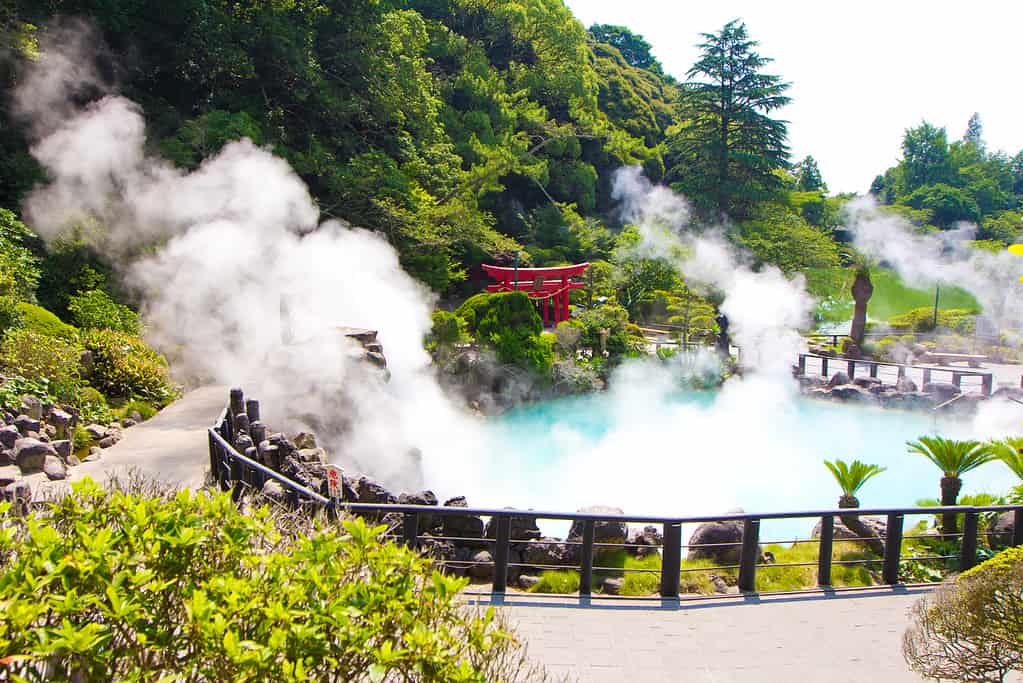
Onsens only exist in Japan.
©pnphotos/iStock via Getty Images
If you’d like to visit an onsen yourself, you’ll need to travel to Japan. There, you’ll be able to find onsen towns that offer experiences specifically designed to relax and revitalize you in an onsen. The most popular onsen towns in the country include:
- Kyushu, which has upwards of 30 different onsens to try.
- Beppu, the unofficial “hot spring capital” of Japan.
- Yamagata, home of the Ginza Onsen and a popular winter bathing spot.
- Gunma, with one onsen that features a special cooling process to keep the potency of the water’s minerals.
- Nagano, which has free communal hot springs in town and onsens that grow in popularity with skiers during the winter.
- Atami, which has onsens high in salt content.
- Nikko, which features a national park and ryokan throughout the region to enjoy a soak in an onsen and a traditional Japanese dinner.
Onsen Rules

When bathing in an onsen, be sure to follow all etiquette and rules.
©RyanKing999/iStock via Getty Images
Japan is a country of age-old tradition, order, and manners. Onsens, then, have their own brand of etiquette one must follow if they’re traveling to one.
Bathe Naked
If you’re bathing in an onsen, do not wear a bathing suit. It’s customary to bathe naked in Japan, which is why public baths are divided by gender.
Be Clean
It’s customary to wash the private areas of your body before entering the onsen. After soaking, you’ll shower again.
No Running
There’s no running, swimming, diving, or general rowdiness at onsens. First and foremost, the onsen is meant to be a relaxing place. Second, it can be slippery so moving slowly is the cautious, safe choice.
Keep Your Wits About You
Drunkenness is not allowed in many, if not all, public onsens. This is for both safety and relaxation reasons.
No Washing
Bringing soaps into the onsen will ruin the mineral content, as well as make others uncomfortable. You will shower before and after the onsen, so you don’t need to wash yourself in the soaking tub.
Be Respectful
Public onsens require you to share space with others. When showering before and after, or while you soak, ensure you’re aware of the space you take up and move to make room if and when more people come to join you.
No Glass
Like many community pool decks, glass bottles and cups aren’t allowed. If the glass breaks, not only does the bath need draining (which is a beast unto itself) but bathers inside are naked, and shattered glass poses extreme harm.
Wipe Off
It’s proper protocol to wipe yourself off before entering the locker room. This prevents you from tracking water into the locker room. Many choose to wear a yukata, or a sort of bathing kimono, after wiping themselves off and entering the locker room.
Tattoos
Etiquette remains important to maintain a relaxing bathing experience in Japan. For generations, tattooed guests have not been widely allowed in public onsens. If you have tattoos and want to go to an onsen, tattoo-friendly onsens exist, or you can opt for a private onsen.
Types of Onsens
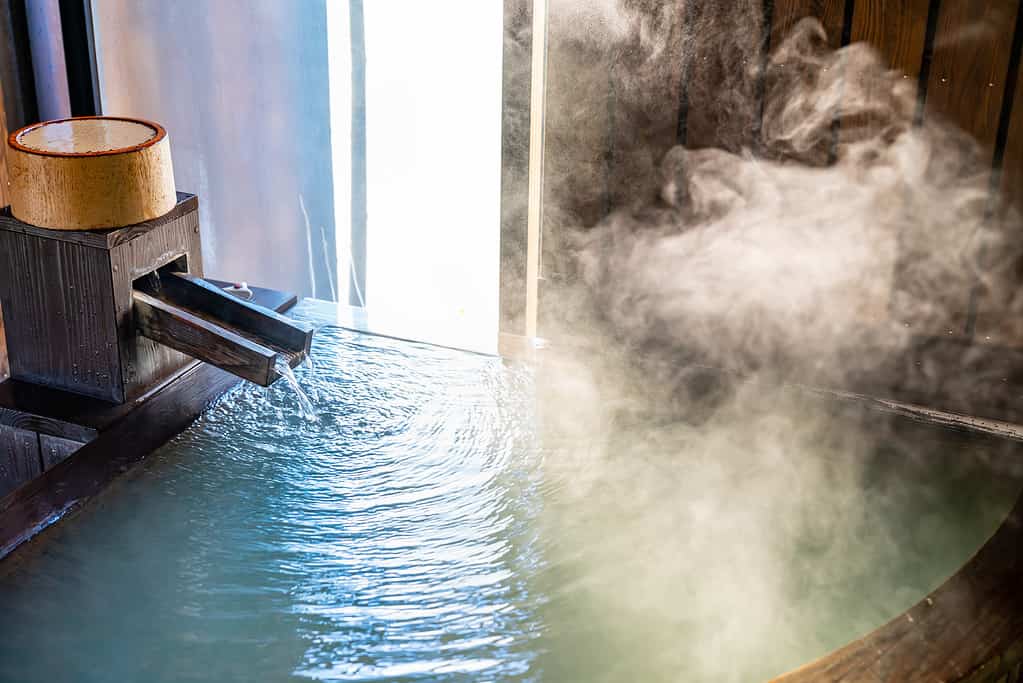
Japan has different types of onsens based on the accessibility and minerals of the bath.
©shirosuna-m/iStock via Getty Images
Throughout Japan, you’ll find dozens of different types of onsens. Here’s a brief overview of some of the kinds you’ll most often encounter.
Public Onsen
Communal bathing is a normal part of Japanese culture. Public onsens aren’t in the middle of the street, as the name might suggest — they’re openly available for the public to use for a fee. Most public onsens are separated by gender.
Private Onsen
Conversely, private onsens are meant only for you and your partner. Foreigners, especially those with tattoos or those not used to public bathing environments, like to choose private onsens for a more personal experience.
Tattoo-Friendly Onsen
Several decades ago, the Japanese most often associated tattoos with Japanese crime families; namely, the Yakuza. The aversion stuck, so onsens remain largely tattoo-free. As the global attitude toward tattoos begins to shift toward an art form rather than a criminal brand, more and more onsens have popped up in Japan that allow tattoos.
Mineral-based Onsens
Because an onsen needs to have at least one of the 19 different chemicals outlined by the Japanese government, some onsens have a very high amount of a single element. This includes alkaline onsens, iron onsens, and sulfur onsens — which each have their own benefits.
Mizuburo
While not an onsen, mizuburo remains an essential part of bathing culture in Japan. Great for fans of the ice plunge trend, mizuburos are cold baths that bathers dunk themselves in after a sauna or onsen session. You should absolutely shower after the onsen or sauna and before the mizuburo to make sure you don’t bring sweat or other impurities from your body into the cold bath.
Benefits of Onsens
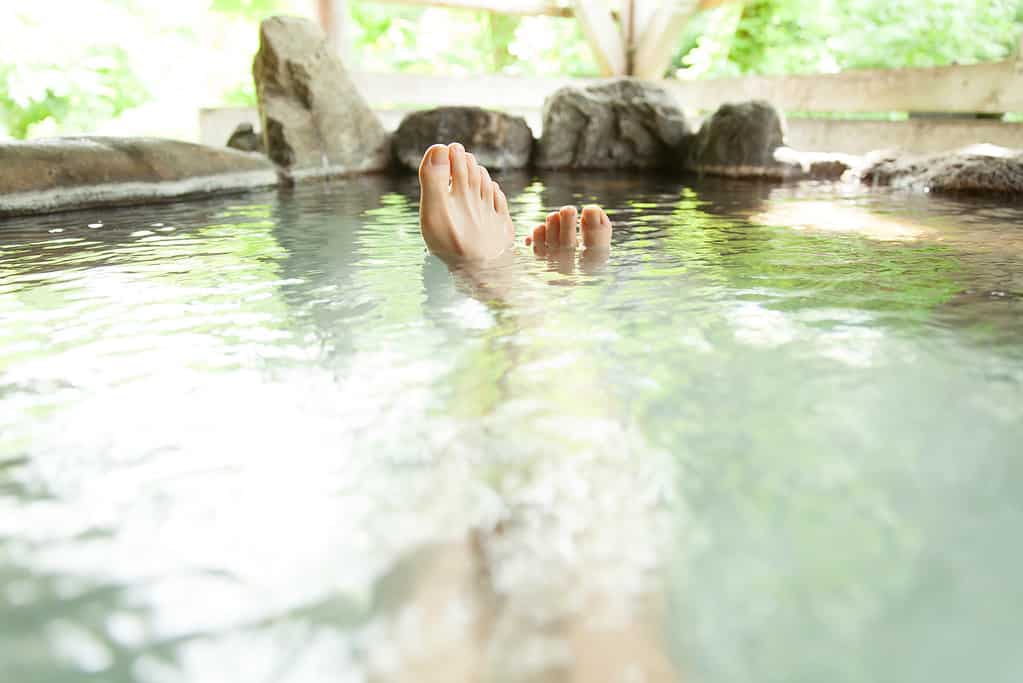
Onsens provide pain relief, decreased stress, and more.
©okugawa/iStock via Getty Images
The unique, traditional, and beloved bathing culture of Japan wouldn’t exist without clear benefits. For centuries, the Japanese have sworn by the advantages onsens bring. They include:
- Cleanliness. Based on the bathing protocol of getting in and out of an onsen, it’s clear the Japanese care deeply about hygiene and keeping themselves clean. Onsens promote cleanliness, both in taking care of your own body and caring for public and private spaces so others can be clean, too.
- Pain relief. Hot springs in general have a variety of advantages. Bathing in an onsen has been shown to reduce swelling, soothe aching joints, and provide pain relief — even temporarily.
- Stress reduction. Bathing culture in Japan hinges on creating a calm, relaxing environment. It’s a shared activity between family members, friends, and coworkers that brings an essence of calm to otherwise stressful and busy lives.
- Improved sleep. Along with stress reduction comes better sleep. Onsens can quiet the mind, relax the muscles, and prepare the body to go into a deeper sleep.
- Better blood flow. Because onsens have different minerals within their waters, your skin can absorb some — like sodium bicarbonate — that keeps your blood properly oxygenated. Better blood flow, in turn, helps to heal wounds faster, provides a natural blush to your face, and keeps your organs working well.
Legends and myths claim that samurais bathed together in onsens to heal their wounds after battle. Though the bathers in modern-day Japan don’t sport sword wounds, they can use onsens to unwind after a particularly stressful day at the office or improve their complexions.
Doumo arigatou gozaimasu!
Or, thank you very, very much! Japan has a long and proud tradition ingrained within its culture, and foreigners who actively take an interest in learning proper onsen etiquette show true respect for both the country’s culture and its people.
If and when you travel to Japan, brush up on your key phrases like this one to ensure you can communicate with the locals through basics like, please and thank you. Be sure to try out the different types of onsens, too, to find your favorite.
The photo featured at the top of this post is © NattaneeP/iStock via Getty Images
Thank you for reading! Have some feedback for us? Contact the AZ Animals editorial team.







